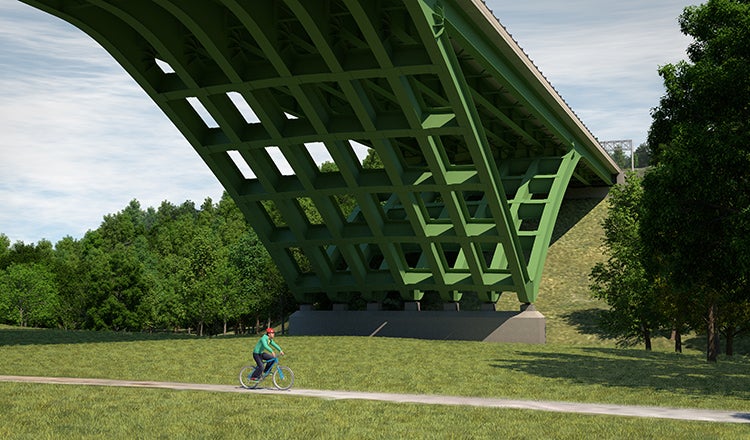I-376 Commercial Street Bridge Replacement

I-376 Commercial Street Bridge Replacement
Using Accelerated Bridge Construction to Replace a Historically Significant Bridge on Alignment
- Performed historic bridge rehabilitation assessment that determined need for bridge replacement
- Extensive alternatives analysis that led to slide-in bridge construction method to minimize traffic impacts
- National bridge team developed and reviewed six design concepts to select community-supported arched delta bridge frame
The I-376 Commercial Street Bridge — passing over Nine Mile Run, Frick Park and Commercial Street in Pittsburgh — has been a reliable carrier of 100,000 vehicles daily, but continuous maintenance to keep up with increasing deterioration of the more-than-70-year-old structure has become costly. The bridge’s condition has also restricted permit loads on this major route. Replacing the existing bridge with one that improves efficiency by accommodating larger load vehicles and maintains reliability for commuters has been a priority for the Pennsylvania Department of Transportation (PennDOT).
HDR has played a major role in the $95 million project, serving as the engineer of record for PennDOT District 11. Starting in 2019, we provided early review of the bridge’s historic nature to help PennDOT select a bridge replacement option that enhances reliability and safety while maintaining the aesthetic of the original bridge. In addition to the alternatives analysis, we provided preliminary engineering and final design for what will be one of the largest slide-in projects in the country while also providing support during construction.
An Innovative Replacement
Because of the bridge’s historical significance to the area, a rehabilitation and historic bridge assessment was conducted by our team at the onset of the project. It concluded that any major restoration of the original structure to meet the project's purpose and need would compromise its historical nature.
During the alternatives analysis, our team evaluated two bridge construction methods: conventional staged and slide-in construction. Staged construction would've required building the bridge in partial widths, requiring years of traffic shifts during bridge development. Slide-in construction was ultimately chosen as the preferred method due to reduced impact on interstate traffic and reduced risk to construction personnel from drivers.
The project team tapped into HDR’s diverse group of national bridge engineering and architecture professionals to develop six bridge design options that would align with both construction methods, including:
- Steel arch
- Concrete arch
- Haunch steel plate girder
- Steel tied arch
- Haunch steel plate girder
- Arched steel delta frame
Community input gathered during stakeholder and public coordination meetings led by our team revealed the desire to maintain the open arch appearance of the current bridge. Furthermore, typical arch bridges produce large thrust forces at the ends of the arch, preventing slide-in construction. With these considerations, the arched delta frame design was chosen to adhere to public preference without the thrust of a typical arch, making slide-in construction practical. HDR also developed temporary foundation and slide concepts to help with project bidding, which are being designed by the contractor.

Our collaboration resulted in a final design that will improve the driver experience. The new bridge’s open rail design will offer views of the landscape and park below and wider shoulders to accommodate stalled traffic and reduce the impact of routine maintenance on traffic. The structure will also be waterproofed and deck beam joints triple-protected to reduce future deterioration from road salt.
Based on our design for PennDOT, the new bridge will be constructed on temporary foundations south of the existing bridge. Once complete in summer 2026, the interstate will be closed, the current bridge will be demolished, and the new bridge will be laterally slid into place using hydraulic jacks. The bridge deck surface will then be connected to the existing roadway with precast concrete pieces and high early strength concrete to accelerate construction of the approach structures and allow traffic to use the new structure quicker.





